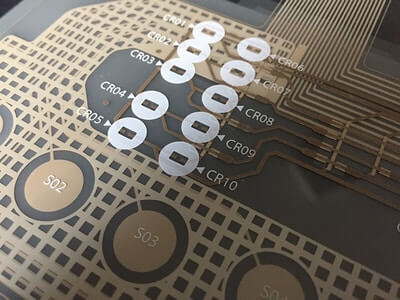For many products today, capacitive touch interfaces have become a popular alternative to traditional interfaces such as hard buttons, elastomer keypads, or membrane switches. Their ease of use, as well as the ability for cap touch to be integrated into several different products, allows for cap touch to be utilized within many household products. But what are the benefits of utilizing cap touch over other traditional interfaces?
Benefits of Capacitive Touch:
 Greater Design Flexibility
Greater Design Flexibility
Capacitive Touch interfaces can be incorporated into products with curved surfaces, which allows for greater design flexibility of your product.
Durability
Because there are no moving parts within a cap touch design, it provides more durability to your product and reduces the number of components within the product’s design.
Appearance
With cap touch design, there are no buttons or switches in the creation of the product, which allows for a smooth and sleek appearance. It also allows for ease of cleaning the product and the sealed design.
Lighting Capabilities
Lighting effects can be easily incorporated into cap touch designs to enable the end-user to know when the product is functioning. Because there are no buttons, there is also no tactile feel. However, once the design is interacted with, a lighting element can enable the end-user to recognize that the buttons on the screen have been clicked.
Water-Resistant
Capacitive touch interfaces can also be created to be water-resistant, which is especially important in situations where the cap touch interface may be exposed to moisture. An example could be a cap touch interface being utilized for a boating control system or within a bathroom of a home.
Cap Touch in Your House:
 Capacitive touch is becoming more and more common in today’s world. These interfaces may even be utilized within your house without you even recognizing it. Take for instance your kitchen. Does your fridge have a touch sensor-enabled into the fridge that dispenses water and ice? You may recognize that the buttons have no tactile feel, but they light up as you push them. This is a simple example of cap touch technology being utilized.
Capacitive touch is becoming more and more common in today’s world. These interfaces may even be utilized within your house without you even recognizing it. Take for instance your kitchen. Does your fridge have a touch sensor-enabled into the fridge that dispenses water and ice? You may recognize that the buttons have no tactile feel, but they light up as you push them. This is a simple example of cap touch technology being utilized.
The same could be said for your dishwasher, microwave, or any other appliance found within your kitchen. Although they aren’t extremely common, this technology will soon be used within many of your daily appliances.
Another common example would be the lighting system in your house. Although you may have the traditional on and off switch for lights within your house, imagine a world where you one day just simply have to touch an interface design that controls your lights. There’s no switch being utilized because the cap touch sensor would control the lights within your house. This is an example of how capacitive touch technology can soon be incorporated into your daily lives.
What about a remote control? Traditionally, remotes are made with silicone rubber keypads. You can experience the tactile feel of clicking a button on your remote as you push the button down and release it. But what if remotes were created completely of a touch interface? There wouldn’t be any physical buttons, but as you touch each individual function on the remote it would light up. This would provide the end-user feedback, as well as provide a smoother, sleeker surface for you to interact with. It would make cleaning of the remote so much easier, as there are no crevices or buttons that dirt can build up in.
Although this technology isn’t commonly known within our daily lives, cap touch is the future of human interface designs. Before you know it, you’ll recognize cap touch within several different appliances or applications in your household and daily lives. Are you ready for it?
To learn more about cap touch, or to get your next cap touch project started with us, reach out! We’ll be happy to help!
 Meet the Author: Jaclyn King
Meet the Author: Jaclyn King
Jaclyn is a Digital Marketing Specialist on the BTI Team. Her main job responsibilities involve inbound marketing, content creation, and social media management. To get to know more about Jaclyn, check her out on LinkedIn!